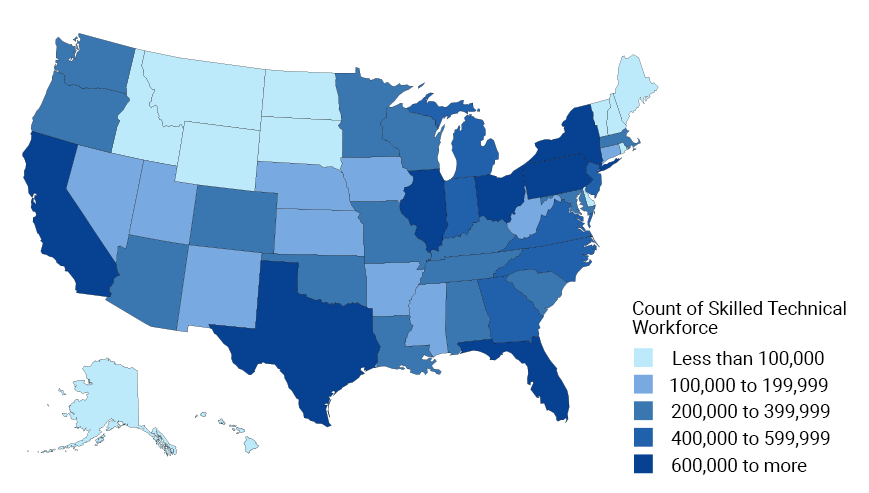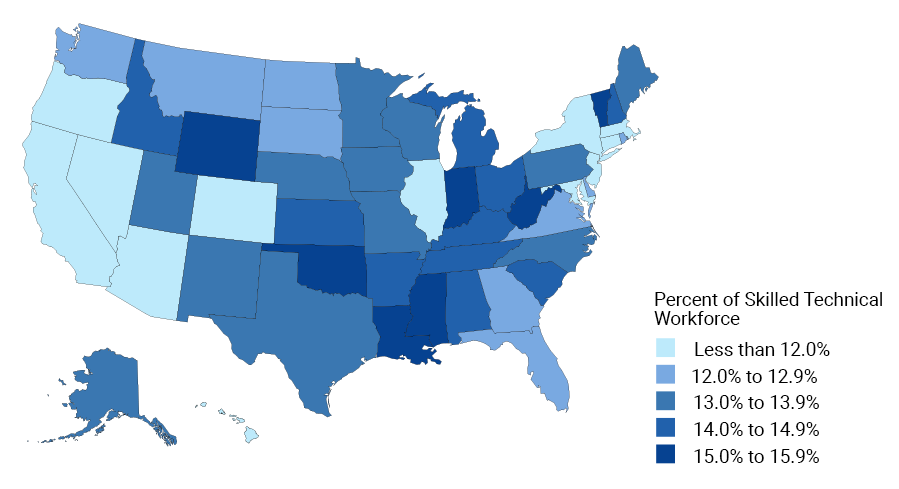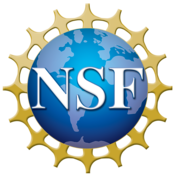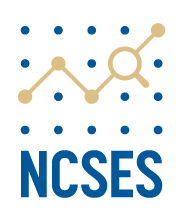Skilled Technical Workforce Initiative
One emerging research area for the National Center for Science and Engineering Statistics (NCSES) is the workforce that is highly skilled in science and engineering (S&E) fields but does not possess a bachelor's degree or above. The American workers who make up this vital subpopulation of the American workforce are referred to as the skilled technical workforce (STW). The pervasiveness of science and technology in society, including its central role in the economy, has changed the nature of work, making skilled technical workers increasingly important to U.S. economic competitiveness, national security, and scientific progress. Currently, there is a lack of information about these workers, making it difficult for policymakers, employers, educational institutions, and researchers to understand or address issues affecting this component of the overall workforce.
Workforce Statistics:
The STEM Workforce of the United States
Learn more about how the U.S. science, technology, engineering, and mathematics (STEM) workforce fuels innovation and provides important contributions to the nation.
NCSES, as an independent federal statistical agency, serves as a clearinghouse for objective data on the U.S. science and engineering workforce and has developed a broad understanding of the policy issues that concern skilled technical workers. Thus, NCSES is well positioned to champion a coordinated effort to address the lack of information on the STW. In response to interest from the National Academies' Committee on National Statistics, the National Science Board's STW Task Force, and the Innovations in Mentoring, Training, and Apprenticeships Act (2018), NCSES has established an STW Initiative that includes five major activities. Together, these activities constitute a framework to guide NCSES's efforts to measure and understand the STW.
The graphic below depicts the large body of work on the STEM-capable U.S. workforce and the contribution NCSES seeks to add to that work through the NCSES STW Initiative. NCSES has committed resources to describe and measure the STW. However, this STW Initiative requires cooperation, collaboration, and coordination among the entire STEM stakeholder community to develop national policies, processes, and programs that support this important segment of the workforce.
This Web page provides an overview of the NCSES STW Initiative and its activities.
Contents
- NCSES STW Initiative
- Quick STW Statistics
- Define STW: A Working Definition
- Conduct Stakeholder Outreach
- Analyze Federal Survey Data
- Analyze Existing Administrative Data and Other Supplementary Resources
- Develop a New Survey: The National Training, Education, and Workforce Survey (NTEWS)
NCSES STW Initiative
- Purpose and goals
-
Employers demand technically skilled employees but are unable to identify and hire qualified workers. Researchers, educators, and policymakers interested in the STW also drive the need for federal data sources that can describe, understand, and measure the STW. With a legislative mandate to collect and disseminate data on the U.S. science and engineering workforce, NCSES aims to contribute to the existing body of knowledge on the STW, a subpopulation of the American workforce that is "foundational and essential" to the science and engineering enterprise (National Science Board STW Task Force Final Report, 2019). To meet this goal, NCSES has created a framework for measuring and understanding the STW by undertaking five activities: 1) developing a definition of the STW, 2) performing stakeholder outreach, 3) documenting current federal STW-related activities and data collections, 4) identifying potential STW-related administrative data, and 5) developing a new, national STW survey.
- Accomplishments to date
-
- Developed a working definition of the STW
- Engaged with STW-related stakeholders for input and potential partnerships
- Analyzed existing federal STW-related data sources
- Developed an online inventory of STW-related administrative data
- Developed plans for the National Training, Education, and Workforce Survey (NTEWS)
- Next steps
-
NCSES will release a report that documents a framework based on the STW Initiative to support NCSES's continued efforts to research and measure the STW. More detailed STW information will inform the U.S. educational system, professional training programs, and the labor market to advance STW policies, processes, and program decisions.
For additional information on STW and on the STW working group, see outreach materials prepared by NCSES.
<back to top>Quick STW Statistics

NOTES: The skilled technical workforce consists of individuals age 25 years and older who do not possess a bachelor's degree and work in highly technical fields, such as construction and extraction; installation, maintenance, and repair; health care; production; and computer and mathematics.
SOURCE: U.S. Census Bureau, American Community Survey Public Use Microdata Sample file, 2017.

NOTES: The skilled technical workforce consists of individuals age 25 and older who do not possess a bachelor's degree and work in highly technical fields, such as construction and extraction; installation, maintenance, and repair; health care; production; and computer and mathematics. Percentage was calculated by taking the proportion of the number of persons in the skilled technical workforce and the number of persons age 25 and older who were employed in the U.S. workforce.
SOURCE: U.S. Census Bureau, American Community Survey Public Use Microdata Sample file, 2017.
Define STW: A Working Definition
A working definition of the STW was established for policy discussions and measurement purposes. STW occupations are those that use significant levels of S&E expertise and technical knowledge but do not necessarily require a bachelor's degree for entry. This activity provides a working definition of STW across different NCSES data products, such as the Science and Engineering Indicators and Diversity and STEM: Women, Minorities, and Persons with Disabilities reports.
NCSES publications that apply the STW working definition:
2020 S&E Indicators Report Chapter 1 – Transition to the Skilled Technical Workforce
2020 S&E Indicators Report Chapter 3 – The Skilled Technical Workforce
Conduct Stakeholder Outreach
A communication plan and outreach documents were developed to provide NCSES management, partners, and stakeholders with an overview of the milestones, timing, and progress of the STW Initiative. Also, this activity involves the planning and execution of engagement sessions and workshops as needed to gather and understand the data and policy needs of STW stakeholders.
<back to top>Analyze Federal Survey Data
Existing federal survey data collections were reviewed to evaluate whether the data provide the information needed to measure and understand the STW. This evaluation considered the availability, coverage, reliability, granularity, and sustainability of estimates. The findings were summarized in a federal survey data sources inventory. Further work in this area includes conducting an annotated bibliography of key and recent research on the STW. Although the National Academies of Science, Engineering, and Medicine (NASEM) report, Building America's Skilled Technical Workforce (2017), provided a comprehensive examination of the STW topic, the research cited in the report is from 2015 or earlier. As a supplement to the NASEM report, this activity examines key research used in the development of the STW definition, as well as relevant research papers published since 2015.
Summary Table. Comparisons of 10 federal data collections
Summary Table. STW-related data collected
STW annotated bibliography (forthcoming)
<back to top>Analyze Existing Administrative Data and Other Supplementary Resources
In response to declining response rates in federal surveys and encouraged by the recently enacted Foundations for Evidence-Based Policymaking Act of 2019, federal statistical agencies are exploring data-leveraging opportunities through administrative and other supplemental data. This activity evaluated and summarized the fitness of use of STW-related employee and employer administrative data and other sources. The findings are summarized in an inventory of administrative and other data sources, along with case studies that identify promising STW-related administrative data to leverage STW-federal data.
Online inventory of National Administrative Data in collaboration with the University of Virginia
<back to top>Develop a New Survey: The National Training, Education, and Workforce Survey (NTEWS)
This new federal survey will measure the education, training, and career pathways of the STW. Preparing for this survey includes developing an appropriate data collection methodology, evaluating sampling frame options, and testing survey content.
NCSES is planning a federal sample survey referred to as the National Training, Education, and Workforce Survey (NTEWS). This survey will be a voluntary data collection sponsored by NCSES and by the National Center for Education Statistics within the Department of Education. The U.S. Census Bureau will be the data collection contractor for the NTEWS.
OMB Information for Collection Request Approval
Census-NTEWS respondent website
For more NTEWS information please reach out to the contact point persons listed below.
<back to top>Contact Information
For more information on the NCSES STW Initiative, please contact:
Gigi Jones, Ph.D.
Project Officer, Skilled Technical Workforce Initiative and National Training, Education, and Workforce Survey
gijones@nsf.gov
John Finamore
Chief Statistician
jfinamore@nsf.gov
Last Updated: May 2020







